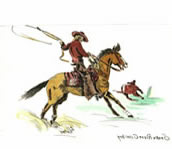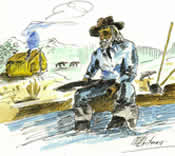

Chapter
1 The Restless Pioneer

Chapter
2 Development of the Settlements

Chapter
3 Teaching Days

Chapter
4 Ranching on Snake River

Chapter
5 The Winding Trail from Robinette to Huntington

Chapter
6 Tribulations and Tragedy

Chapter
7 Ghosts of the Connor Creek Gold

Chapter
8 Reflections on the River

Chapter
9 The Last Roundup
Chapters
CHAPTER 1. THE RESTLESS PIONEER
"Oregon" was the dream. "On to Oregon", the motto. The Spring of 1879, Eugene Sullivan with his young family joined a Wagon Train on its way to Oregon. In Eugene's heart lived a dream of cheap fertile land, a new home, and a better life for his family.
The burden of carving a home from dry sagebrush hills in Eastern Oregon seemed insurmountable for Eugene Sullivan. He suffered many struggles and hardships including the loss of his young wife, Luella, and the anguish of how to provide for his baby son alone.
CHAPTER 2. DEVELOPMENT OF THE SETTLEMENTS
Oregon Territorial Governor, Joseph Gale and his Indian wife Eliza, choose a lovely spot along Eagle Creek for their home and started the first New Bridge Post Office and Community in Eagle Valley.
It was the Powder River and Eagle Creek area of Eagle Valley as well as the fertile land in Pine Valley and along the Snake River of Baker County where Indians once had camped that allured many settlers, homesteaders and adventurers.
These hardy pioneers fought Indians, grubbed sagebrush, dug ditches, hewed out farms and established communities which progressed and blossomed for awhile.
The little towns of Richland and Halfway have survived the advancement of modern progress while other historic towns, such as New Bridge, Pine Town, Robinette, Home and Gypsum are now only memories.
CHAPTER 3. TEACHING DAYS
Prim Schoolmarm Jessie Sullivan, timidly accepted an offer to teach the first Robinette School the fall of 1910. There, Jessie boarded with Grandma (Eva) Robinette, and loved to listen to stories of Eva's childhood and about her cousin, Abraham Lincoln.
Other country schools that Jessie Sullivan taught were at Upper Dry Creek in Pine Valley; Manning Creek School near Lookout Mountain; Park Creek; and Home Schools on Snake River. While teaching school on Snake River, Jessie Sullivan found friendship, romance and a new life.
CHAPTER 4. RANCHING ON SNAKE RIVER
Albert Cummings, a drifting cowboy with his pack horse, headed for Wyoming the spring of 1898. While passing through the Snake River area, he acquired a run down 160 acre ranch with a dugout for living quarters . To this ranch he brought his new bride in 1914.
CHAPTER 5. THE WINDING TRAIL from ROBINETTE to HUNTINGTON
There were few meager trails into the Snake River Canyon before roads were established. But somehow, settlers, ranchers, miners, immigrants, adventurers, and outlaws, established homes along the Snake River in an effort to eke out a living.
One adventurer, an immigrant youth from Palos, Romania, developed a family ranching spread and became" Cattle King" of the Snake River Canyon.
CHAPTER 6. TRIBULATIONS AND TRAGEDY
The Home Cemetery near Hibbard Creek holds in its grip many secrets of local tragedies.
There among the grave stones are the names of Mr. Evans, Bessie and George, who died August 8, 1908, and Gerald, in 1922. Snake River claimed them all.
CHAPTER 7. GHOSTS OF THE CONNOR CREEK GOLD
Gold was the attraction! Connor Creek and the Snake River area is well known for its fine specimens of coarse gold and gold nuggets.
Searching for gold is a way of life in the Snake River Canyon, for the gold still awaits. Yes, there is "Gold in them thar Hills."
CHAPTER 8. REFLECTIONS on the RIVER
Buying a gold mine sight-unseen had been foolish, admitted Asa Whitney that February day in 1933, as he caught first sight of the gold claim on the Idaho side of frozen Snake River.
His large family would have to live in dugouts. Fresh water and food supplies as well school for the children would have to be made daily by row boat, to the Oregon side of Snake River, as there was no other way to access this claim.
CHAPTER 9. THE LAST ROUNDUP
By January 1958 the Huntington-Robinette division of the Union Pacific Railroad became a Ghost Line. One by one the ranches along Snake River had been acquired, some by condemnation. Bitterness, anger and frustration ensued as the ranchers relinquished their way of life along Snake River.
The Round-up is over and all that remains to be seen are the steep, barren slopes overlooking the still waters of Brownlee Reservoir, and the secrets of those who lived there.
APPENDIX
A. The Family Circle"The Family Circle" contains the final memories in the Journal of Jessie Sullivan Cummings and completes this book.
B. Footsteps"Footsteps" is the product of research of the Family Tree of Samuel Wells Sullivan, dating back to 1777.
Copyright
2006 by Lillian Cummings Densley
All Rights Reserved
All Rights Reserved